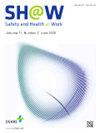Systematizing Information Use to Address Determinants of Health Worker Health in South Africa: A Cross-sectional Mixed Method Study
IF 3.5
3区 医学
Q1 PUBLIC, ENVIRONMENTAL & OCCUPATIONAL HEALTH
引用次数: 0
Abstract
Background
Recognizing that access to safe and healthy working conditions is a human right, the World Health Organization (WHO) calls for specific occupational safety and health (OSH) programs for health workers (HWs). The WHO health systems’ building blocks, and the International Labour Organization (ILO), highlight the importance of information as part of effective systems. This study examined how OSH stakeholders access, use, and value an occupational health information system (OHIS).
Methods
A cross-sectional survey of OSH stakeholders was conducted as part of a larger quasi experimental study in four teaching hospitals. The study hospitals and participants were purposefully selected and data collected using a modified questionnaire with both closed and open-ended questions. Quantitative analysis was conducted and themes identified for qualitative analysis. Ethics approval was provided by the University of Pretoria and University of British Columbia.
Results
There were 71 participants comprised of hospital managers, health and safety representatives, trade unions representatives and OSH professionals. At least 42% reported poor accessibility and poor timeliness of OHIS for decision-making. Only 50% had access to computers and 27% reported poor computer skills. When existing, OHIS was poorly organized and needed upgrades, with 85% reporting the need for significant reforms. Only 45% reported use of OHIS for decision-making in their OSH role.
Conclusion
Given the gap in access and utilization of information needed to protect worker’s rights to a safe and healthy workplace, more attention is warranted to OHIS development and use as well as education and training in South Africa and beyond.
系统化信息用于解决南非卫生工作者健康的决定因素:一项横断面混合方法研究
世界卫生组织(世卫组织)认识到获得安全和健康的工作条件是一项人权,呼吁为卫生工作者制定具体的职业安全和健康(OSH)方案。世卫组织卫生系统的组成部分和国际劳工组织(劳工组织)强调了信息作为有效系统一部分的重要性。本研究考察了职业健康安全利益相关者如何获取、使用和评估职业健康信息系统(OHIS)。方法对四所教学医院的职业安全与健康利益相关者进行横断面调查,作为大型准实验研究的一部分。有目的地选择研究医院和参与者,并使用带有封闭式和开放式问题的修改问卷收集数据。进行定量分析,确定主题进行定性分析。伦理批准由比勒陀利亚大学和英属哥伦比亚大学提供。结果调查对象包括医院管理人员、健康安全代表、工会代表和职业安全健康专业人员共71人。至少42%的人报告说,职业健康信息系统决策的可及性和及时性较差。只有50%的人可以使用电脑,27%的人表示自己的电脑技能很差。现有的OHIS组织不善,需要升级,85%的人报告需要进行重大改革。只有45%的人报告在职业安全卫生角色中使用职业健康信息系统进行决策。结论:鉴于在获取和利用保护工人享有安全和健康工作场所权利所需的信息方面存在差距,有必要更多地关注职业健康信息系统的发展和使用以及南非和其他国家的教育和培训。
本文章由计算机程序翻译,如有差异,请以英文原文为准。
求助全文
约1分钟内获得全文
求助全文
来源期刊

Safety and Health at Work
Social Sciences-Safety Research
CiteScore
6.40
自引率
5.70%
发文量
1080
审稿时长
38 days
期刊介绍:
Safety and Health at Work (SH@W) is an international, peer-reviewed, interdisciplinary journal published quarterly in English beginning in 2010. The journal is aimed at providing grounds for the exchange of ideas and data developed through research experience in the broad field of occupational health and safety. Articles may deal with scientific research to improve workers'' health and safety by eliminating occupational accidents and diseases, pursuing a better working life, and creating a safe and comfortable working environment. The journal focuses primarily on original articles across the whole scope of occupational health and safety, but also welcomes up-to-date review papers and short communications and commentaries on urgent issues and case studies on unique epidemiological survey, methods of accident investigation, and analysis. High priority will be given to articles on occupational epidemiology, medicine, hygiene, toxicology, nursing and health services, work safety, ergonomics, work organization, engineering of safety (mechanical, electrical, chemical, and construction), safety management and policy, and studies related to economic evaluation and its social policy and organizational aspects. Its abbreviated title is Saf Health Work.
 求助内容:
求助内容: 应助结果提醒方式:
应助结果提醒方式:


